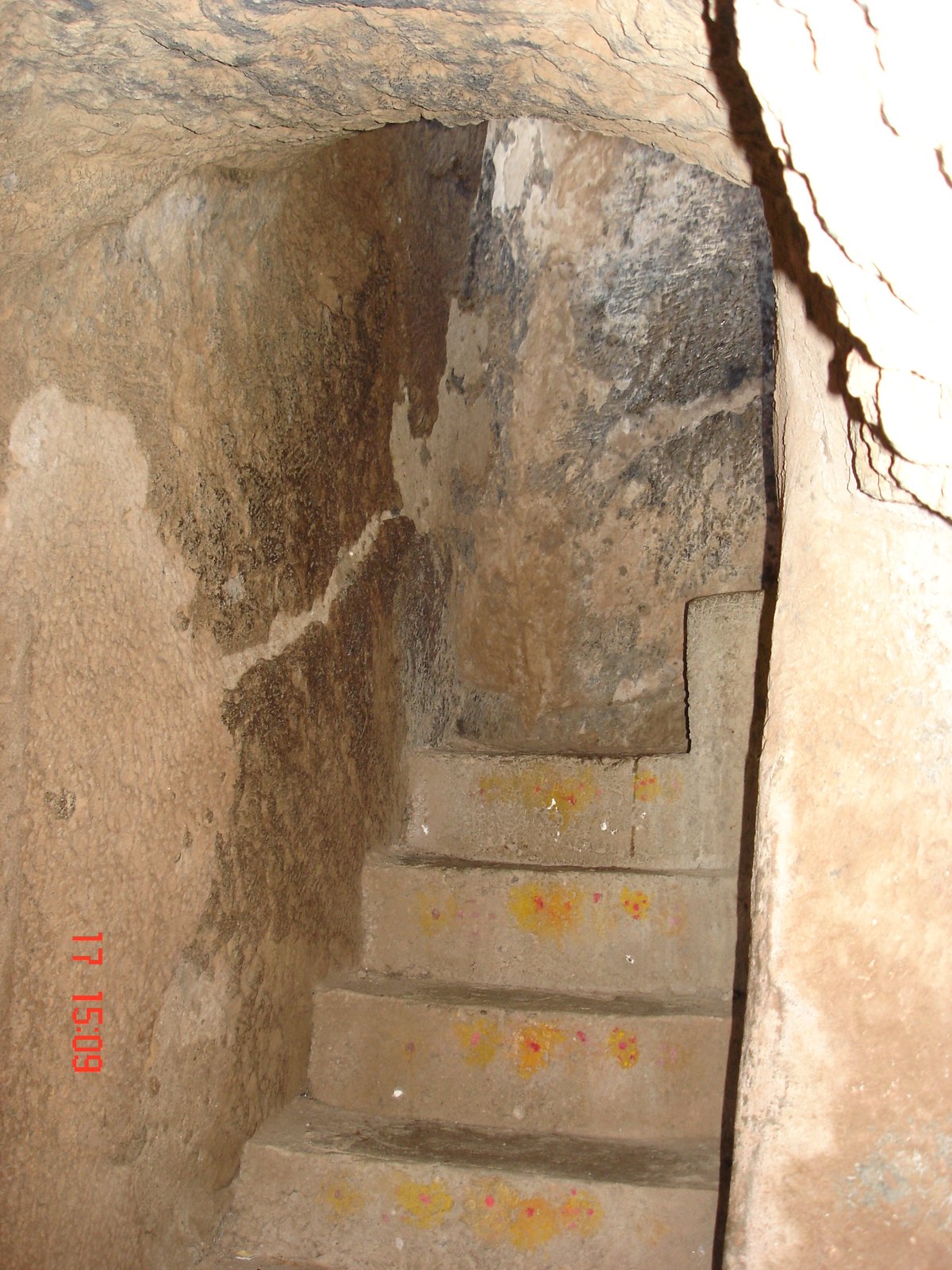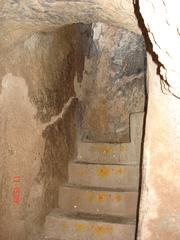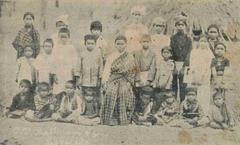
Undavalli Caves Visiting Hours, Tickets, and Guide to Vijayawada Historical Sites
Date: 14/06/2025
Introduction
Nestled on a sandstone hillside overlooking the Krishna River near Vijayawada, the Undavalli Caves stand as a testament to India’s enduring spiritual and architectural heritage. Dating back to the 4th–5th centuries CE, these ancient rock-cut caves showcase a remarkable blend of Jain, Buddhist, and Hindu influences. Originally established as a Jain monastic complex, they later served as a Buddhist vihara before their transformation into Hindu temples under the Vishnukundina dynasty. The caves’ multi-storeyed architecture, intricate sculptures, and the iconic 5-meter-long monolithic reclining Vishnu (Ananta Padmanabha) sculpture are emblematic of ancient Indian artistry and religious syncretism.
Today, the Undavalli Caves attract history enthusiasts, spiritual seekers, and tourists. Conveniently located near Vijayawada, the site is supported by well-maintained facilities, guided tours, and proximity to prominent attractions like Bhavani Island and Kanaka Durga Temple. This guide explores the history, architecture, visitor information, travel tips, and preservation efforts associated with the Undavalli Caves, ensuring a well-informed and enriching visit.
For up-to-date details, refer to the Andhra Pradesh Tourism website and the Archaeological Survey of India. For immersive experiences, see Ancient Terminus, Viharadarshani, and ExploreOurIndia.
Table of Contents
- Early Origins and Religious Foundations
- Hindu Reappropriation and the Vishnukundina Dynasty
- Architectural Development and Features
- Visitor Information: Hours, Tickets & Travel Tips
- Frequently Asked Questions (FAQ)
- Preservation and Modern Significance
- Visual Gallery, Map, and Virtual Tour
- Nearby Attractions
- Practical Visitor Tips
- Conclusion
Early Origins and Religious Foundations
Jain Beginnings
The earliest phase of the Undavalli Caves is attributed to Jain monks in the 4th–5th centuries CE. The architectural style and presence of Jain tirthankara sculptures draw parallels with the Udayagiri and Khandagiri caves in Odisha, highlighting a once-thriving Jain community (Wikipedia; Ancient Terminus; Viharadarshani).
Buddhist Transformation
Following its Jain phase, the caves became a Buddhist monastic center. Remnants of Buddhist sculptures—including an impressive reclining Buddha—along with meditation cells and communal halls, reflect the needs of Buddhist monks during this era (Ancient Terminus; Viharadarshani).
Hindu Reappropriation and the Vishnukundina Dynasty
Conversion and Patronage
Under the Vishnukundina dynasty (420–620 CE), the caves underwent a significant transformation. Initially Buddhist patrons, the rulers later embraced Brahminical Hinduism, commissioning elaborate sculptures, shrines, and the monumental four-storey sandstone structure that defines the site today (The History Hub; Adotrip; Wikipedia).
Syncretism and Artistic Evolution
Even after becoming a Hindu temple complex, the site retained Jain and Buddhist elements, visible in its iconography and architectural motifs. The sanctuaries dedicated to Brahma, Vishnu, and Shiva, alongside Jain and Buddhist artwork, showcase the region’s inclusive spiritual landscape (Ancient Terminus; Viharadarshani).
Architectural Development and Features
Multi-Storeyed Monolithic Structure
The main cave is an east-facing, four-storey monolithic structure, approximately 29 meters long and 16 meters wide (ExploreOurIndia; TravelTriangle). Each level reflects the evolving spiritual and functional needs of the site:
- Ground Floor: An unfinished pillared hall with broad doorways, likely intended for gatherings.
- First Floor: Contains triple sanctuaries for the Hindu Trimurti and retains Jain and Buddhist features (Indianetzone).
- Second Floor: Houses the monumental reclining Vishnu (Ananta Padmanabha) statue, carved from a single granite block (eIndiaTourism; TripXL).
- Top Floor: Remains unfinished, with later-period sculptural elements.
Sculptures and Decorative Elements
The caves are adorned with intricate carvings of deities, mythological figures, animals, and Jain tirthankaras, reflecting religious syncretism (YoMetro; ExploreOurIndia). Murals on the first floor, dating to the 7th–8th centuries CE, showcase regional artistic expertise (Indianetzone).
Engineering and Construction
The caves’ rock-cut methodology required precise planning and craftsmanship. Strategic design ensures natural light, ventilation, and effective drainage from the hillside location (TheMysteriousIndia; TravelTriangle).
Visitor Information: Hours, Tickets & Travel Tips
Visiting Hours
- Open: Daily from 9:00 AM to 6:00 PM
- Best time to visit: October to March (cooler months); early morning or late afternoon recommended
Tickets and Entry Fees
- Indian nationals: ₹30 per person
- Foreign nationals: ₹100–₹200 per person (varies by source)
- Children (below 15): Free or discounted entry
- Photography: Allowed, but flash and tripods may be restricted
Accessibility and Facilities
- Location: About 6–15 km southwest of Vijayawada; well connected by road (My Holiday Happiness; Trip.com)
- Transport: Buses, taxis, auto-rickshaws from Vijayawada; parking available
- Amenities: Restrooms and parking at entrance; food stalls nearby, but not inside complex
- Mobility: Uneven terrain and stairs; limited wheelchair access
Travel Tips
- Wear comfortable footwear
- Carry water, sun protection, and rain gear (in monsoon)
- Modest dress is recommended; remove footwear in sanctified areas
- Consider hiring a local guide for deeper insights
Frequently Asked Questions (FAQ)
Q1: What are the Undavalli Caves visiting hours?
A: Open daily from 9:00 AM to 6:00 PM.
Q2: How much are the entry tickets?
A: ₹30 for Indian nationals, ₹100–₹200 for foreign tourists. Children may enter free or at reduced rates.
Q3: Are guided tours available?
A: Yes, local guides are available at the entrance for tours lasting 45–60 minutes.
Q4: Is the site wheelchair accessible?
A: The caves have uneven paths and stairs; accessibility is limited.
Q5: Can I take photographs inside?
A: Photography is generally allowed; restrictions may apply for flash and tripods.
Preservation and Modern Significance
Recognized as a monument of national importance, the Undavalli Caves are protected by the Archaeological Survey of India (Wikipedia; Ancient Terminus). Ongoing conservation focuses on structural stability, artwork preservation, and responsible tourism. The caves remain a vibrant place of worship, especially during major Hindu festivals.
Visual Gallery, Map, and Virtual Tour
Alt text for images includes keywords like ‘Undavalli Caves visiting’, ‘Andhra Pradesh historical site’, and ‘Undavalli Caves tickets’ for SEO.
Nearby Attractions
- Kanaka Durga Temple: Iconic temple atop Indrakeeladri Hill, 8 km away (TransRentals)
- Bhavani Island: River island with water sports and picnics, 10 km away (Adotrip)
- Amaravati: Buddhist stupa and museum, 32 km away (Traveler Bibles)
- Kondapalli Fort: Hilltop fort and Kondapalli toy village, 25 km away (Adotrip)
- Mogalarajapuram Caves: Ancient rock-cut caves, within 5 km of Vijayawada (Adotrip)
- Kolleru Lake: Bird sanctuary, 47 km away (Adotrip)
- ISKCON Vijayawada: Meditation and cultural events (TransRentals)
Practical Tips for Visitors
- Use local transport or hire a taxi from Vijayawada.
- Carry water and snacks; dining options at the site are limited.
- Respect heritage norms: do not touch carvings or murals.
- Allocate 1–2 hours for a full visit, more if exploring nearby attractions.
- Follow site rules on photography and footwear.
Conclusion
The Undavalli Caves are a living heritage site, offering a compelling journey through India’s religious and architectural history. Their syncretic past, stunning rock-cut architecture, and ongoing cultural relevance make them an essential stop in Vijayawada. Plan your visit for the cooler months, consider a guided tour, and explore the wealth of nearby attractions for a complete Andhra Pradesh experience.
For further details, download the Audiala app or consult official tourism resources.
References and Further Reading
- Undavalli Caves - Wikipedia
- Ancient Terminus
- Viharadarshani
- The History Hub
- Adotrip
- ExploreOurIndia
- TravelTriangle
- Indianetzone
- TheMysteriousIndia
- eIndiaTourism
- TripXL
- YoMetro
- South Tourism
- Trawell.in
- Times of India
- News Bharati
- Andhra Pradesh Tourism
- Archaeological Survey of India
- My Holiday Happiness
- Trip.com
- TripClap
- TransRentals
- Traveler Bibles

